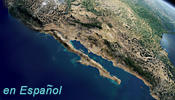![[Ocean Oasis Field Guide]](images/bnr-oo-field.gif)

![[Ocean Oasis Field Guide]](images/bnr-oo-field.gif) |  |
|
Larus heermanni Family: LARIDAE (Skuas, Jaegers, Gulls, Terns)
DescriptionThe adult Heermann's Gull is the most easily recognized North American gull. In combining its uniformly light gray belly, dark gray back and wings, with a black-tipped red bill, black legs and feet, and white-edged black tail, it is like no other species. During summer, the head is pure white; in winter, mottled with dark gray. The juvenile is uniformly dark sooty brown, also unlike other North American gulls. The young birds take four years to acquire the adultsí colors. Size: Length about 48 cm (19 inches); wingspread about 130 cm (51 inches); weight about 500 grams (18 ounces). Voice: Kwak and a high-pitched weee, nasal and whiny. Range and HabitatRange: Heermann's Gulls nest primarily on islands in the Gulf of California, and the largest colonies are on Rasa and Little Cardinosa island. The Rasa colony numbers around 150,000 to 200,000 pairs. Most other colonies, including those on the San Benito Islands and San Roque Island on the Pacific coast and south on islands off the coast of mainland Mexico to Nayarit, number no more than 300 pairs each. After the breeding season, in midsummer, most of the population migrates north along the Pacific coast of the United States and as far as British Columbia. Some subadult birds remain in this nonbreeding range year round. The only site where Heermann's Gull occurs inland regularly is the Salton Sea in southeastern California, where it is rare but increasing. Habitat: Heermann's Gull is almost exclusively coastal, ranging only a few dozen miles out to sea to forage. Natural HistoryHeermann's Gulls feed mostly on small pelagic fish such as sardines and anchovies, and occasionally on crustaceans, mollusks, and other marine organisms scavenged from the beach, kelp beds, and fishing boat dumps. They are sometimes kleptoparasites of Brown Pelicans and Elegant and Royal Terns. Heermann's Gulls may build a nest of sticks and small rocks, sometimes lined with feathers, on the ground or between large rocks and boulders. Or the "nest" may be a simple depression in the ground with no lining or just a scanty lining of shells or sticks. The clutch consists of one to two eggs, variously colored and patterned with dark spots and blotches. Yellow-footed Gulls prey on their eggs and chicks, particularly in areas of low nesting density. Elegant Terns seek refuge against predation of eggs by Yellow-footed Gulls by nesting inside of Heermann's Gull colonies. |
Text by Philip Unitt with additions by Enriqueta Velarde
Photograph by Bradford Hollingsworth
Field Guide |
Site Index |
Ocean Oasis Introduction
|
|
© 2000 San Diego Natural History Museum |